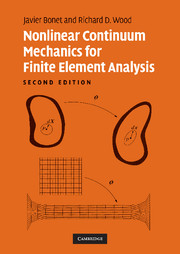Book contents
- Frontmatter
- Contents
- Preface
- 1 INTRODUCTION
- 2 MATHEMATICAL PRELIMINARIES
- 3 ANALYSIS OF THREE-DIMENSIONAL TRUSS STRUCTURES
- 4 KINEMATICS
- 5 STRESS AND EQUILIBRIUM
- 6 HYPERELASTICITY
- 7 LARGE ELASTO-PLASTIC DEFORMATIONS
- 8 LINEARIZED EQUILIBRIUM EQUATIONS
- 9 DISCRETIZATION AND SOLUTION
- 10 COMPUTER IMPLEMENTATION
- Bibliography
- Index
7 - LARGE ELASTO-PLASTIC DEFORMATIONS
Published online by Cambridge University Press: 06 July 2010
- Frontmatter
- Contents
- Preface
- 1 INTRODUCTION
- 2 MATHEMATICAL PRELIMINARIES
- 3 ANALYSIS OF THREE-DIMENSIONAL TRUSS STRUCTURES
- 4 KINEMATICS
- 5 STRESS AND EQUILIBRIUM
- 6 HYPERELASTICITY
- 7 LARGE ELASTO-PLASTIC DEFORMATIONS
- 8 LINEARIZED EQUILIBRIUM EQUATIONS
- 9 DISCRETIZATION AND SOLUTION
- 10 COMPUTER IMPLEMENTATION
- Bibliography
- Index
Summary
INTRODUCTION
Many materials of practical importance, such as metals, do not behave in a hyperelastic manner at high levels of stress. This lack of elasticity is manifested by the fact that when the material is freed from stress it fails to return to the initial undeformed configuration, and instead permanent deformations are observed. Different constitutive theories or models such as plasticity, viscoplasticity, and others are commonly used to describe such permanent effects. Although the mathematics of these material models is well understood in the small strain case, the same is not necessarily true for finite deformation.
A complete and coherent discussion of these inelastic constitutive models is well beyond the scope of this Chapter. However, because practical applications of nonlinear continuum mechanics often include some permanent inelastic deformations, it is pertinent to give a brief introduction to the basic equations used in such applications. The aim of this introduction is simply to familiarize the reader with the fundamental kinematic concepts required to deal with large strains in inelastic materials. In particular, only the simplest possible case of Von Mises plasticity with isotropic hardening will be fully considered, although the kinematic equations described and the overall procedure will be applicable to more general materials.
We will assume that the reader has some familiarity with small strain inelastic constitutive models such as plasticity because several of the key equations to be introduced will not be fully justified but loosely based on similar expressions that are known to apply to small strain theory. More in-depth discussions can be found in Bibliography.
- Type
- Chapter
- Information
- Nonlinear Continuum Mechanics for Finite Element Analysis , pp. 188 - 215Publisher: Cambridge University PressPrint publication year: 2008

